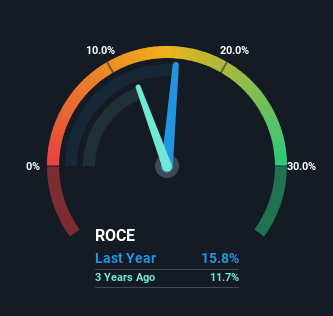- China
- /
- Consumer Durables
- /
- SZSE:002543
Here's What To Make Of Guangdong Vanward New Electric's (SZSE:002543) Decelerating Rates Of Return

If we want to find a stock that could multiply over the long term, what are the underlying trends we should look for? Typically, we'll want to notice a trend of growing return on capital employed (ROCE) and alongside that, an expanding base of capital employed. This shows us that it's a compounding machine, able to continually reinvest its earnings back into the business and generate higher returns. With that in mind, the ROCE of Guangdong Vanward New Electric (SZSE:002543) looks decent, right now, so lets see what the trend of returns can tell us.
Return On Capital Employed (ROCE): What Is It?
For those that aren't sure what ROCE is, it measures the amount of pre-tax profits a company can generate from the capital employed in its business. The formula for this calculation on Guangdong Vanward New Electric is:
Return on Capital Employed = Earnings Before Interest and Tax (EBIT) ÷ (Total Assets - Current Liabilities)
0.16 = CN¥753m ÷ (CN¥8.9b - CN¥4.2b) (Based on the trailing twelve months to March 2024).
Thus, Guangdong Vanward New Electric has an ROCE of 16%. In absolute terms, that's a satisfactory return, but compared to the Consumer Durables industry average of 8.4% it's much better.
See our latest analysis for Guangdong Vanward New Electric

In the above chart we have measured Guangdong Vanward New Electric's prior ROCE against its prior performance, but the future is arguably more important. If you're interested, you can view the analysts predictions in our free analyst report for Guangdong Vanward New Electric .
What Can We Tell From Guangdong Vanward New Electric's ROCE Trend?
While the returns on capital are good, they haven't moved much. The company has employed 28% more capital in the last five years, and the returns on that capital have remained stable at 16%. Since 16% is a moderate ROCE though, it's good to see a business can continue to reinvest at these decent rates of return. Over long periods of time, returns like these might not be too exciting, but with consistency they can pay off in terms of share price returns.
On a separate but related note, it's important to know that Guangdong Vanward New Electric has a current liabilities to total assets ratio of 47%, which we'd consider pretty high. This can bring about some risks because the company is basically operating with a rather large reliance on its suppliers or other sorts of short-term creditors. Ideally we'd like to see this reduce as that would mean fewer obligations bearing risks.
The Key Takeaway
In the end, Guangdong Vanward New Electric has proven its ability to adequately reinvest capital at good rates of return. However, over the last five years, the stock has only delivered a 38% return to shareholders who held over that period. So to determine if Guangdong Vanward New Electric is a multi-bagger going forward, we'd suggest digging deeper into the company's other fundamentals.
Guangdong Vanward New Electric does have some risks though, and we've spotted 1 warning sign for Guangdong Vanward New Electric that you might be interested in.
While Guangdong Vanward New Electric may not currently earn the highest returns, we've compiled a list of companies that currently earn more than 25% return on equity. Check out this free list here.
New: Manage All Your Stock Portfolios in One Place
We've created the ultimate portfolio companion for stock investors, and it's free.
• Connect an unlimited number of Portfolios and see your total in one currency
• Be alerted to new Warning Signs or Risks via email or mobile
• Track the Fair Value of your stocks
Have feedback on this article? Concerned about the content? Get in touch with us directly. Alternatively, email editorial-team (at) simplywallst.com.
This article by Simply Wall St is general in nature. We provide commentary based on historical data and analyst forecasts only using an unbiased methodology and our articles are not intended to be financial advice. It does not constitute a recommendation to buy or sell any stock, and does not take account of your objectives, or your financial situation. We aim to bring you long-term focused analysis driven by fundamental data. Note that our analysis may not factor in the latest price-sensitive company announcements or qualitative material. Simply Wall St has no position in any stocks mentioned.
About SZSE:002543
Guangdong Vanward New Electric
Provides solutions for kitchen and bathroom appliances and hot water heating systems in China and internationally.
Flawless balance sheet average dividend payer.
Market Insights
Community Narratives




